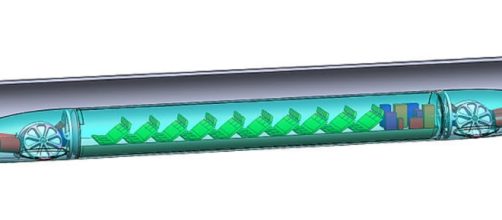The Hyperloop One Global Challenge has narrowed down the proposals to build lines of the revolutionary transportation technology developed by Elon Musk to ten in the United States, the United Kingdom, Canada, Mexico, and India. One of the finalists is a Texas Hyperloop line that would connect Houston, Austin, San Antonio, Dallas, and Laredo.
What is a Hyperloop?
A Hyperloop involves building a steel tube with reduced air pressure between two destinations. Specially designed pods that contain people or freight would be sent through the tubes, elevated by air bearings and propelled by induction motors.
Because of lack of friction and air resistance, these pods could move at supersonic speeds, reducing trip times between cities such as, say, Houston and Dallas from hours to minutes. The tubes would either be elevated on pylons along their routes or, in a new concept developed by Elon Musk for a northeast corridor Hyperloop, buried beneath the earth in specially bored tunnels.
How would the Hyperloop Line in Texas work?
The Texas Hyperloop Line would connect the major Cities Of Texas, plus Laredo on the Mexican border, in a transportation system that could take people and goods at speeds of up to 700 miles an hour. According to its page on the Hyperloop One site, the Texas line would allow the shipment of goods from manufacturing plants in Mexico to customers in Texas seamlessly, avoiding waits that can last weeks due to congestion on highways.
Moreover, the Texas Hyperloop would relieve congestion on Highway 35 between Dallas and Laredo and Interstate 10 between Houston and San Antonio. Trip times on the Hyperloop would be remarkable, with less than nine minutes between Houston and San Antonio and about 20 minutes between Austin and Dallas.
What happens next?
The Austin Business Journal reports that Hyperloop One will work with the ten finalists to create an analysis that will look at “initial ridership forecasts, business cases and preliminary technical analyses of the routes and corridors.” The goal is to create three Hyperloop lines by 2021.
No doubt a great many technical and regulatory challenges remain before the first passengers and cargo are whisked between destinations in the first Hyperloop line.
Among the questions posed by critics is the following; how are these lines to be protected from terrorist attacks? Also, how will the Hyperloop operate during a power outage? Some experts claim that the technology is impractical due to costs and other considerations, a supposition that is hotly disputed by Elon Musk and others. Efficient transportation would foster enough economic growth and relieve enough congestion in traditional transportation lines such as highways and rail to more than justify the cost of Hyperloop lines, according to its supporters.


